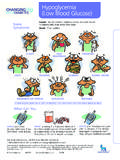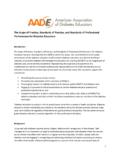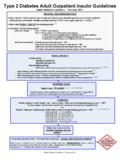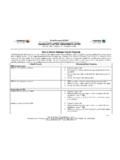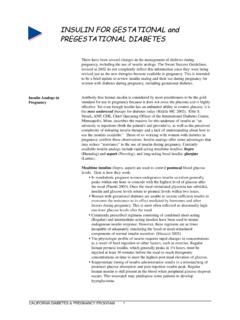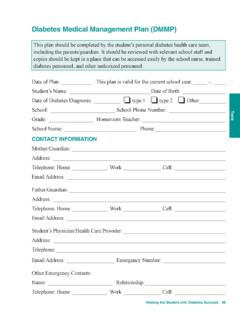Transcription of Inpatient Management of Hyperglycemia and Diabetes
1 F E A T U R E A R T I C L E. Inpatient Management of Hyperglycemia and Diabetes Vasudev Magaji, MD, MS, and Jann M. Johnston, MD. U. ncontrolled Hyperglycemia in cal advice on managing Inpatient unless it is a very brief hospitaliza- hospitalized patients with or Hyperglycemia . tion. Oral agents can be restarted without a previous diagnosis as patients approach discharge or of Diabetes is associated with adverse General Guidelines transfer to a nonacute setting. outcomes and longer lengths of stay. Hyperglycemia is defined as blood Metformin cannot be used when In addition to the increasing preva- glucose > 140 mg/dl, and treatment there is any possibility of the need for lence of Diabetes in the United States, is recommended when glucose levels iodinated contrast studies or renal many patients without preexisting are persistently > 140 180 insufficiency.
2 Sulfonylureas and Diabetes experience stress-related A1C is an important laboratory test metaglinides can cause unpredictable Hyperglycemia during hospitaliza- that should be ordered in nondiabetic hypoglycemia in patients who are not It is estimated that one-third hyperglycemic patients and diabetic eating reliably. Thiazolidinediones of hospitalized patients will experi- patients who have not had a recent can cause fluid retention, espe- ence significant The test. An A1C value can now cially in combination with insulin . cost associated with hospitalization be used for diagnosing Diabetes and Parenteral glucagon-like peptide-1. for patients with Diabetes accounts is valuable in distinguishing between and amylin agonists can cause nau- for half of all health care expendi- preexisting Diabetes and acute stress sea and should be withheld in acutely tures for this 5 Controlling Hyperglycemia .
3 In patients with ill patients. For these reasons, inpa- glucose levels for inpatients should be preexisting Diabetes , A1C testing will tient Hyperglycemia is best managed a priority for hospitals and practic- indicate the adequacy of prehospital- with insulin only. ing physicians. Recent guidelines for ization treatment and can help guide insulin works reliably, and doses optimal glucose goals in hospitalized discharge planning. Red blood cell can be rapidly adjusted depending patients have been developed by the transfusion during hospitalization on changes in glucose levels and American Association of Clinical will falsely decrease A1C food intake. Use of insulin does Endocrinologists (AACE) and the Patients with Diabetes or hyper- not necessarily commit patients to American Diabetes Association glycemia who are eating should be chronic insulin therapy as outpa- (ADA).
4 6 on a consistent-carbohydrate diet, tients, and this should be discussed Controlling glucose and avoiding and glucose monitoring should be with patients to allay any potential hypoglycemia is challenging even for ordered before each meal and at bed- anxiety. If the A1C value indicates experienced clinicians. Acute illness, time. Typically, oral agents should the need for chronic insulin therapy, inconsistent caloric intake, changes be discontinued during acute illness it is a good idea to begin discussion from home medications, and limita- and training as soon as possible. tions regarding the timing of glucose IN BRIEF. monitoring and insulin administra- Subcutaneous insulin Therapy in Control of Hyperglycemia in Hospitalized Patients tion are all significant obstacles to hospitalized patients is important managing Inpatient Hyperglycemia .
5 Many types of insulin and insulin for optimal clinical outcomes, A good understanding of the regimens can be used effectively to but can be very challenging. This principles of physiological insulin control glucose in the outpatient article provides practical recom- delivery is essential to overcom- setting. insulin therapy during mendations for insulin therapy ing these obstacles and achieving hospitalization requires flexibility to for common situations that arise glucose goals. The purpose of change rapidly with the patients' con- during hospitalization. this article is to provide practi- dition and is best provided by what CLINICAL Diabetes Volume 29, Number 1, 2011 3. F E A T U R E A R T I C L E.
6 Has been termed a basal/bolus insulin regimen. It should be emphasized that using a correction scale insulin regimen, also known as sliding scale insulin , alone is not appropriate to treat sustained Hyperglycemia (> 140 mg/dl). Scheduled basal/. Plasma insulin U/ml bolus insulin is designed to prevent Hyperglycemia , whereas correction scale insulin only attempts to lower Hyperglycemia after it has occurred. A study comparing scheduled basal/. bolus insulin to sliding scale insulin only showed a significantly higher percentage of patients achieving goal glucose levels in the basal/bolus group than in the sliding scale only group (66 vs. 38%) without an increase in Figure 1. Physiological principles of the basal/bolus insulin There are three components to a basal/bolus regimen: basal insulin , utes.
7 Numerous studies have shown patients are not eating, but correc- meal or nutritional bolus insulin , that rapid-acting insulin analogs tion doses should still be given when and correction insulin (Figure 1).9 will control the postprandial rise in needed to treat Hyperglycemia . The ideal basal insulin provides a glucose and reduce later hypoglyce- Standardized, preprinted, or constant 24-hour peakless level of mia better than regular 15 computerized insulin order forms insulin to suppress the liver's release Rapid-acting insulin analogs should improve the ease of ordering insulin of glucose during the fasting state be given 0 15 minutes before a and guide physicians to include all and between meals. NPH insulin meal, whereas regular insulin must three components of subcutane- has a pronounced and variable be given at least 30 minutes before ous therapy.
8 Standardized insulin peak and should be avoided during a meal because of its slower onset orders have been shown to improve hospitalization because it can cause of action. The timing requirements glucose control and reduce medica- unpredictable hypoglycemia, espe- for premeal regular insulin admin- tion 18 For these reasons, cially in patients who are not eating istration are not usually realistic in many hospitals have made the use ,11 Glargine and detemir are a busy hospital unit. Bolus insulin of such orders mandatory. A sample newer insulin analogs that provide should be withheld when patients are preprinted insulin order from the relatively peakless basal insulin . NPO or when premeal glucose levels authors' institution is provided in Glargine is preferred because of its are < 70 mg/dl.
9 Figure 2. longer duration of action with once- Correction insulin is intended to Estimating patients' total daily daily Basal insulin , lower hyperglycemic glucose levels, insulin requirement, or total daily when dosed correctly, should not not to cover nutritional hypergly- dose (TDD), is the first step in cause hypoglycemia when patients cemia. But, as with mealtime bolus ordering insulin . For patients who are restricted from oral nutritional insulin , rapid-acting analog for- were on insulin before admission, intake (NPO). mulations are the best choice for the best indicator of insulin require- Mealtime bolus insulin is correctional insulin for patients who ment is their TDD before admission. designed to prevent the predicted are able to eat.
10 Before each meal, the Regardless of their previous insulin postprandial rise in glucose. Bolus mealtime bolus insulin dose and the regimen, it is best to use a basal/. insulin is best provided with one correction insulin dose can be added bolus regimen during their hospital of the rapid-acting analogs (lis- and administered simultaneously. stay and to explain to patients that pro, aspart, or glulisine) with each However, it is best to order them this is being done to allow for greater meal. These insulin analogs have separately so they can be adjusted flexibility. Patients with an elevated a rapid onset of action and usually independently. The mealtime bolus A1C value may require an increase, reach peak levels within 60 min- insulin should be withheld when and those whose glycemia was 4 Volume 29, Number 1, 2011 CLINICAL Diabetes .
